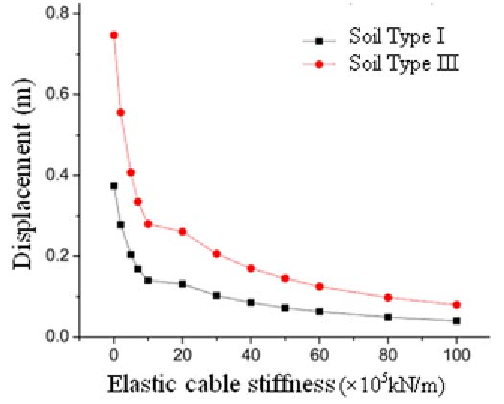Geology Reference
In-Depth Information
Figure 10. Girder end displacement versus elastic cable stiffness
namic characteristics, thus being able to reduce
the seismic demands and improve the seismic
performance of the bridge.
The variations of the girder end displacement
demands are shown in Figure 10 for two differ-
ent site situations (Ministry of Transport of the
People's Republic of China, 2008), based on
results from elastic response spectrum analyses.
The relationships are shown in Figure 11 between
the tower-girder relative displacement and the stiff-
ness. It can be seen that the displacement demands
decrease rapidly as the cable stiffness increases
from 0 to 30×10
5
kN/m and their decreasing rate
becomes insignificant after the stiffness exceeds
30×10
5
kN/m.
On the other hand, the variations of the tower
bottom seismic force demands are shown in Fig-
ure 12 for the same two different site conditions.
It can be seen that the bending moment demands
fluctuate in relatively small amplitude when the
cable stiffness increases, while the shear force
demands monotonously increase.
Therefore it is concluded that the elastic cables
change the seismic force transmission and distri-
bution significantly. The stiffness range from
20×10
5
to 70×10
5
kN/m is practically acceptable
for the elastic cables, in which the displacement
demands are reduced significantly while the mo-
ment and shear force demands have little chang-
es. Thus the rational elastic cable stiffness adjust-
ing strategy may achieve the seismic demand
uniformity along the structural components and
a balance between the force and displacement
demands during the conceptual design.
Seismic Isolation Mechanism
From the parametric analyses, it can be seen that
if the cable stiffness increases the fundamental
period of the bridge will decrease rapidly, the
vibration modes will change, the displacements
will decrease rapidly, the bending moments will
fluctuate in small amplitude and the shear force
will monotonically increase.
The above analyses reveal the core of the seis-
mic isolation mechanism of the elastic cables, the
change of structure system and the transformation
of the force transmission path in the bridge tower.
Because of the limiting function of the elastic
cables, a floating cable-stayed bridge gradually
turns into a semi-floating system, and finally a
tower-girder rigid connection system when the

Search WWH ::

Custom Search